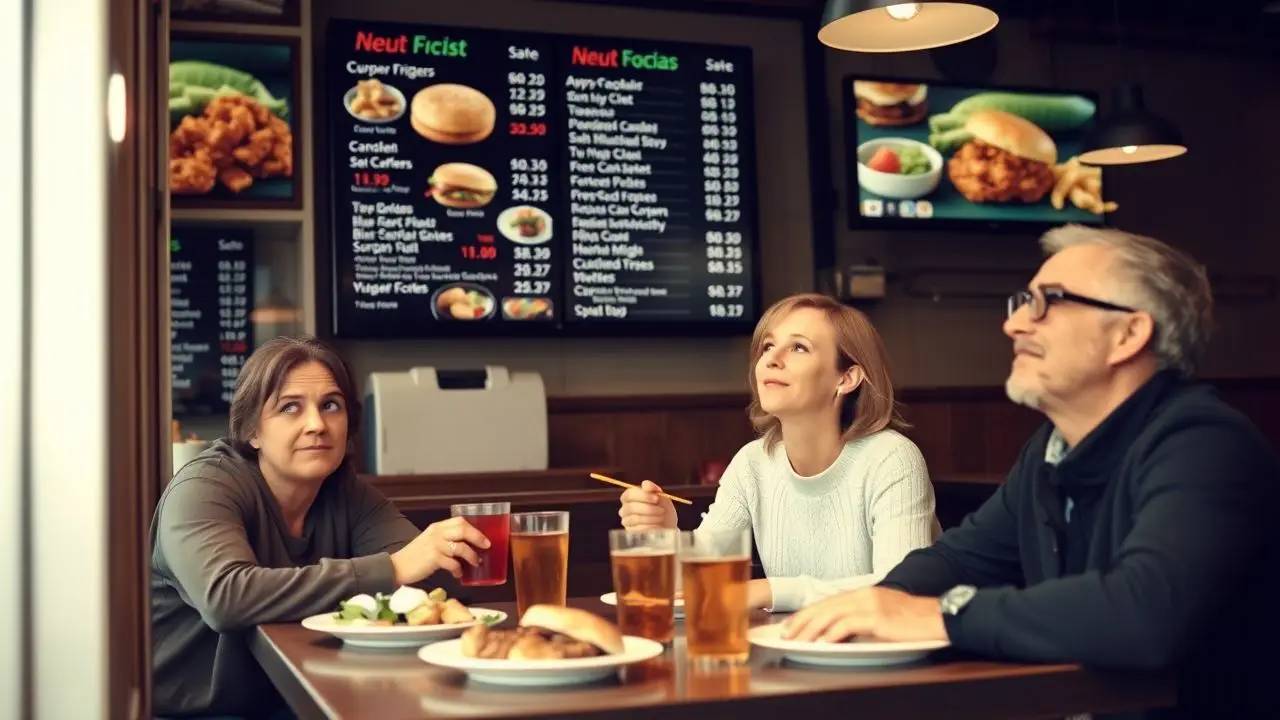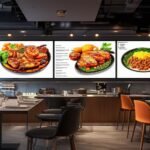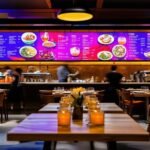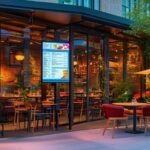Restaurants are always looking for ways to attract more customers. Digital signage is making a big difference in this area. This blog will show how screens and digital displays help restaurants work better and please their guests.
Keep reading to learn more!
Key Takeaways
- Digital signs make restaurants work better. They show menus and specials in a nice way. This helps customers pick what they want faster.
- Kiosks where people order themselves cut down wait times. This makes the customer happy because they get their food quicker.
- Using screens for ordering at tables lets customers change their orders easily. It also keeps the menu exciting with new things to try.
- Signs that change help sell more by showing deals and new items. This can make people buy things like drinks or desserts they didn’t plan to.
- In the future, digital signs will talk to apps on phones. They will offer special deals to match what you like. This means you might see ads just for foods you enjoy eating.
Table of Contents
ToggleHow Digital Signage is Used in the Restaurant Industry

Digital signage is changing how restaurants communicate with their customers. Menu boards and self-ordering kiosks make it easy for guests to see options and place orders quickly.
Menu boards
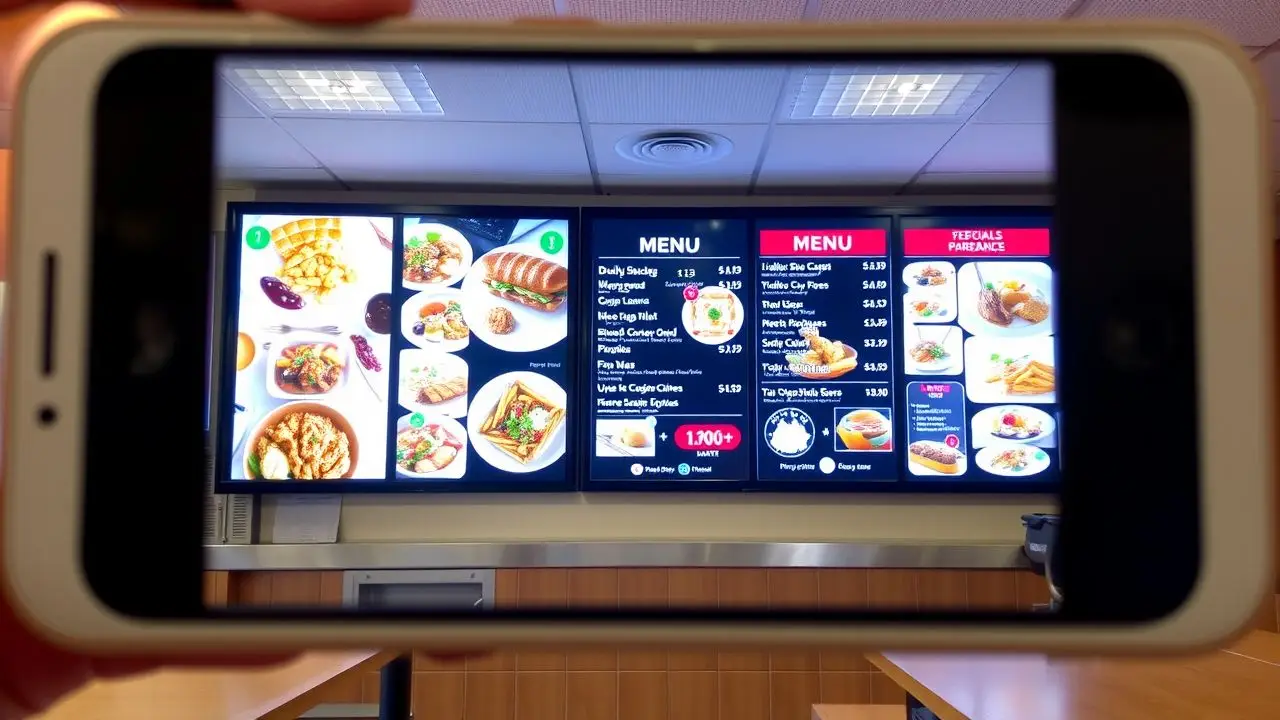
Menu boards play a key role in restaurants. They display food items and prices clearly. With restaurant digital displays, menus can change quickly. This helps keep the information fresh and relevant.
Customers can see tasty images of dishes, which adds visual appeal.
Interactive signage allows guests to explore menu options easily. It can show special offers or new items too. Menu boards help make ordering faster for customers. The use of dynamic content keeps the dining experience engaging and fun.
These features boost sales by catching customer interest more effectively than static boards.
Self-ordering kiosks
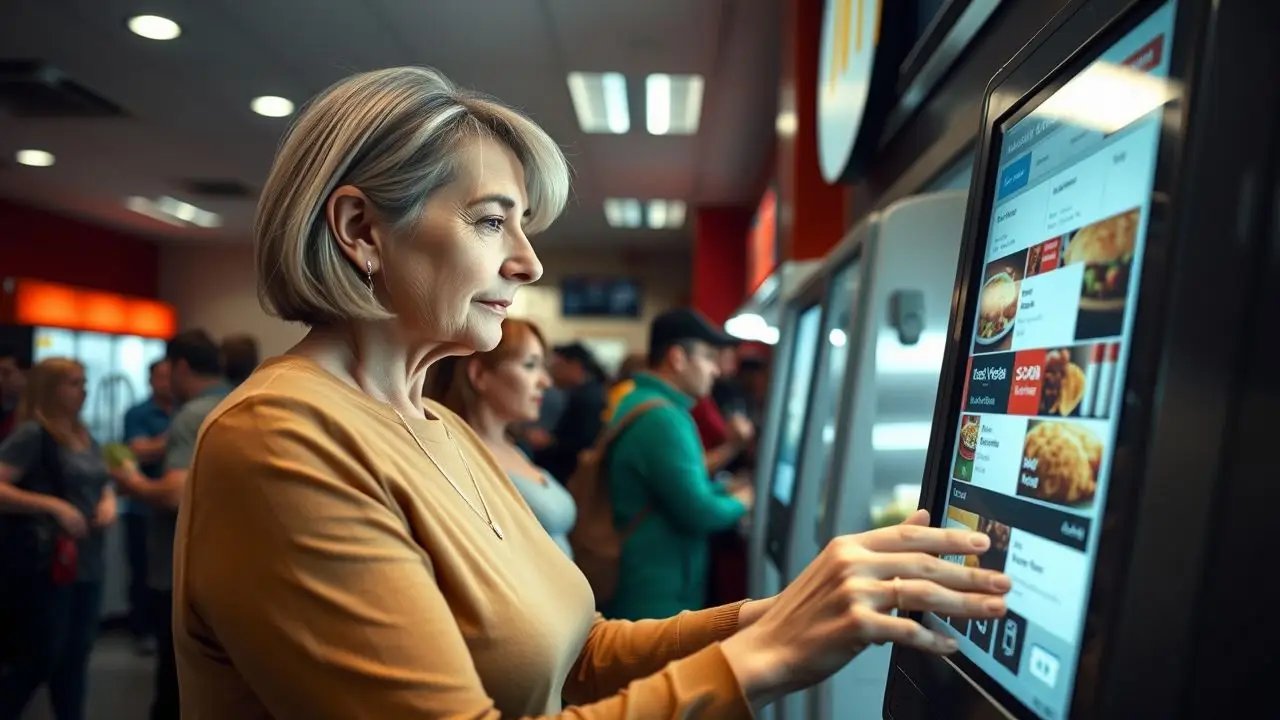
Self-ordering kiosks are changing how customers order food. These interactive displays let people browse the menu at their own pace. They can customize their meals easily. Customers enjoy more control over their dining experience.
Restaurants benefit too. Kiosks streamline operations by reducing wait times. Staff can focus on serving food instead of taking orders. This technology boosts sales by encouraging upselling and cross-selling opportunities, helping restaurants maximize profits.
Digital signage makes these kiosks efficient tools in the hospitality industry, elevating customer engagement while improving service speed and accuracy.
Digital menus and ordering at table
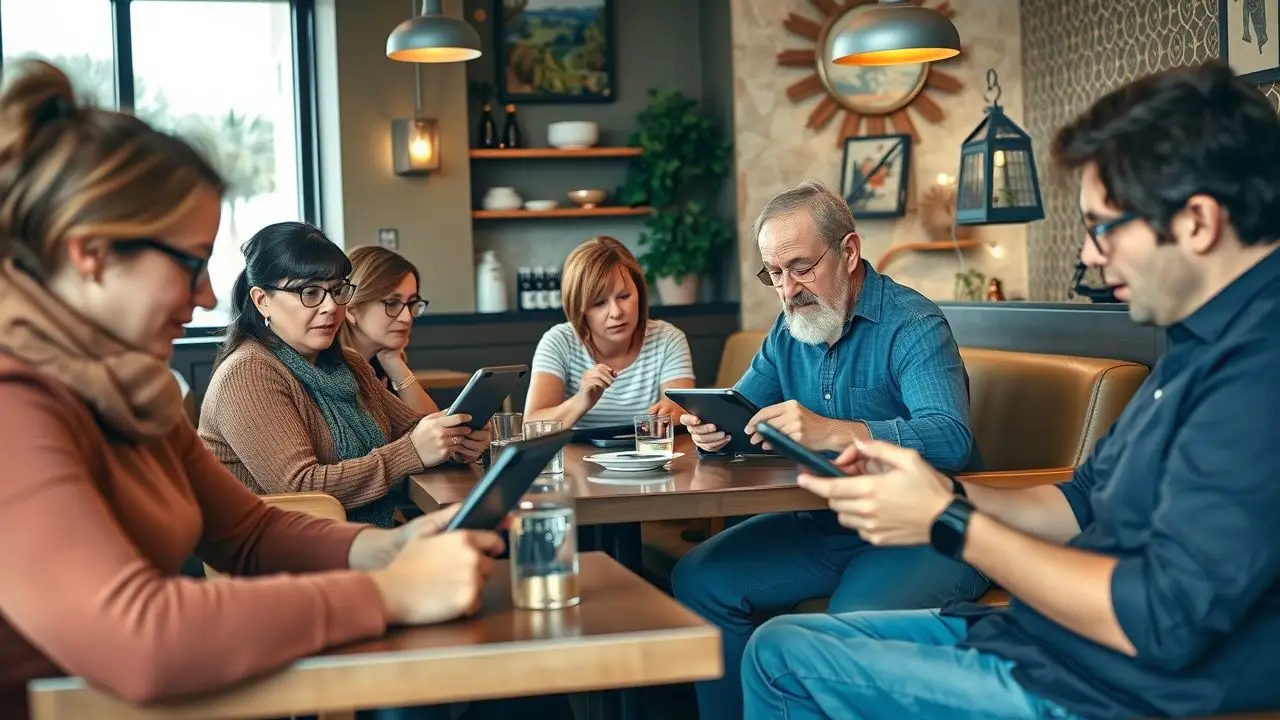
Digital menus and ordering at the table change how customers interact with restaurants. Guests can use tablets or screens to view menus. This option makes it easy to see all food choices and specials.
Customers can order directly from their seats, which speeds up service.
This technology boosts the customer experience. People enjoy browsing through images of meals before they order. It also allows for quick adjustments if someone wants to add or remove items.
Digital menu boards keep information fresh and exciting, helping restaurants market new dishes effectively.
Benefits of Digital Signage for Restaurants
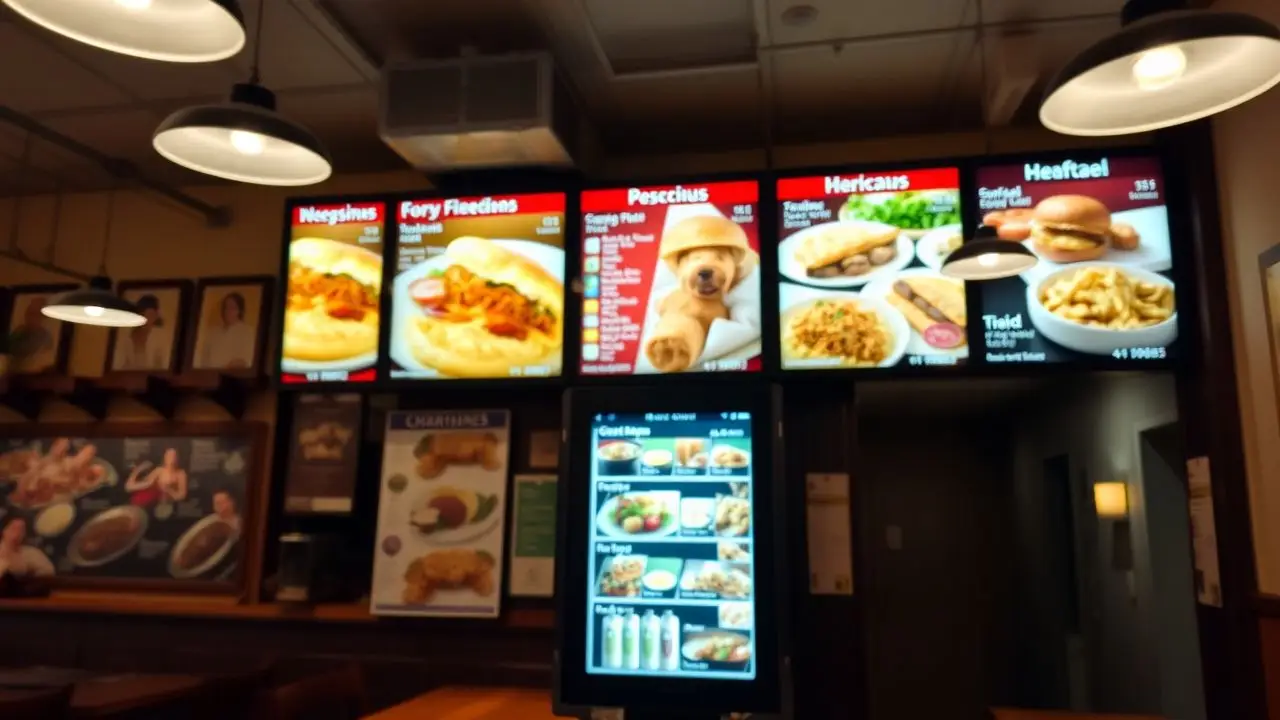
Digital signage helps restaurants run more smoothly. It saves money and boosts customer satisfaction.
Increased efficiency and cost savings
Restaurants gain more efficiency and save money with digital signage. Menu boards can change quickly. They show prices and items without printing new signs. This cuts costs on materials.
Self-ordering kiosks help customers place their orders faster. Fewer mistakes happen when people order themselves. This speeds up the process for everyone, saving labor time in busy restaurants.
The food service industry benefits from these changes, as they boost sales and streamline operations.
Managers can update promotions easily using digital menus at tables. These updates happen in real-time, reaching every customer instantly. In my experience working in a restaurant, all these tools enhance the dining experience while keeping costs low for owners.
Enhanced customer experience
Digital signage greatly enhances the customer experience in restaurants. Menus on screens are clear and vibrant. Customers can see pictures of food, making it easier to choose what they want to eat.
Self-ordering kiosks save time by allowing guests to order at their own pace. They do not have to wait for a server. Digital menus at tables let customers customize their orders quickly.
First-hand experience shows that many diners enjoy this new way of ordering. It feels modern and interactive, adding fun to dining out. Upselling is also easier with digital signs that suggest popular items or combos based on what customers select.
This can lead to a boost in sales while improving customer satisfaction as they receive exactly what they want through restaurant technology like visual communication and touchscreens.
Upselling and cross-selling opportunities
Upselling and cross-selling are key benefits of digital signage in restaurants. Interactive displays can show special deals on drinks or desserts. A customer looking at a menu might see a big picture of a tasty dessert right next to their meal choice.
This visual helps them decide to order more.
QSR businesses use technology integration for this purpose. Staff can suggest food pairings through digital menus. They can highlight popular items or limited-time offers, which boosts sales.
First-hand experience shows that customers are likely to try new things when they see appealing visuals and easy options on screens.
Impact of Digital Signage on Restaurant Operations

Digital signage improves restaurant operations by making the ordering process faster and simpler. It allows for quick updates to menus. This helps keep staff informed about changes.
Better communication between the kitchen and dining area boosts service quality. With these tools, restaurants can share promotions easily. Want to learn how this technology can help your favorite eatery?
Streamlined ordering process
Digital signage makes the ordering process easy for customers. They can choose their meals quickly using menu boards or self-ordering kiosks. This speed helps reduce wait times, making visits more enjoyable.
Customers feel less stressed when they don’t have to wait long.
Staff also benefit from a simpler system. It allows them to focus on helping guests rather than taking orders manually. Better communication between the kitchen and front of house leads to fewer mistakes in orders.
With these changes, restaurants see better efficiency in operations and an increase in sales. Digital signage truly brings innovation in dining experiences.
Real-time updates and customization
Restaurants can change their menus quickly with real-time updates. This helps them show daily specials or new items right away. Staff can swap out dishes that are sold out, too. Customers appreciate seeing fresh options.
Customization makes the dining experience better for each guest. For example, if a diner orders a meal through an app, the restaurant can add notes about allergies or special requests.
This customer-centric approach builds loyalty and satisfaction. Upselling opportunities also arise from this setup as restaurants suggest popular sides or drinks based on what diners choose.
First-hand experience shows that these tools boost sales in QSR business and hospitality establishments alike.
Improved communication between kitchen and front of house
Digital signage helps improve communication between the kitchen and front of house staff. Orders appear on screens in real time. This allows cooks to see what is needed right away.
It cuts down on mistakes and speeds up service.
Staff can update menus quickly, too. If a dish runs out or changes, everyone knows immediately. This brings clarity to the team. Customers feel valued when their orders arrive faster and correctly.
Digital signage truly supports customer-centricity in restaurants.
Marketing and promotional opportunities
Restaurants can use digital signage for effective marketing. Eye-catching displays grab attention and show special deals. Customers notice promotions on menu boards or screens at self-ordering kiosks.
This method boosts sales by enticing customers to try new items.
Promotional content changes easily with digital tools. Restaurants can highlight seasonal dishes or limited-time offers quickly. Interactive signage engages diners, making them more likely to buy extras.
These strategies help create a customer-centric experience while increasing profits.
Future of Digital Signage in Restaurants

The future of digital signage in restaurants looks bright. Restaurants will use mobile apps and loyalty programs to connect more with customers.
Integration with mobile apps and loyalty programs
Digital signage works well with mobile apps and loyalty programs. Customers can order right from their phones. They can see updated menus and special deals. This makes it easy to choose what they want.
Restaurants gain valuable data on customer habits too.
Using digital tools boosts sales by personalizing offerings. For example, if a customer likes burgers, the app can suggest new flavors or combos. Loyalty programs get stronger when linked to signage.
Customers enjoy rewards for their choices, encouraging them to return often. This focus on consumer behavior helps restaurants grow while keeping customers happy.
Personalization and targeted advertising
Personalization and targeted advertising change how restaurants connect with customers. Digital signage can show ads that match a customer’s taste. For example, if a patron frequently orders pizza, the screen can highlight new pizza deals or specials.
This makes menus feel more relevant and exciting.
Restaurants boost sales by using this strategy effectively. Customers appreciate messages that speak directly to them. They are more likely to respond to offers that fit their preferences.
Personalization helps create a better experience while driving sales growth for businesses.
Data tracking and analytics
Digital signage helps restaurants understand their customers better. It tracks what items sell most and at what times. This data shows which meals are popular and which need promotion.
Restaurants can use this information to change menus quickly based on sales data.
Analytics also helps with marketing strategies. Restaurants can target ads to specific groups of people, boosting sales even more. With clear insights, they can make smart decisions that enhance customer-centricity and improve the overall dining experience.
Conclusion

Digital signage is changing how restaurants operate. It makes ordering easier and faster for customers. This technology helps staff communicate better, too. With it, restaurants can update menus quickly and promote special offers right away.
As more places use this tech, the dining experience will keep getting better.
FAQs
1. How is digital signage transforming the restaurant industry?
Digital signage is changing the restaurant industry by boosting sales, enhancing customer-centricity and offering versatile applications.
2. Can digital signage boost sales in my restaurant?
Yes, digital signage can help to increase your sales. It attracts customers with vibrant displays of food and drink specials or new menu items which can lead to more orders.
3. What does it mean for a restaurant to be customer-centric with digital signage?
Being customer-centric means focusing on providing a great experience for your customers. Digital signage helps achieve this by displaying real-time updates, personalized messages or engaging content that enhances their dining experience.
4. What are some versatile applications of digital signage in restaurants?
Versatile applications of digital signs include showcasing daily specials, displaying queue numbers, promoting loyalty programs or even sharing fun facts about food ingredients.
